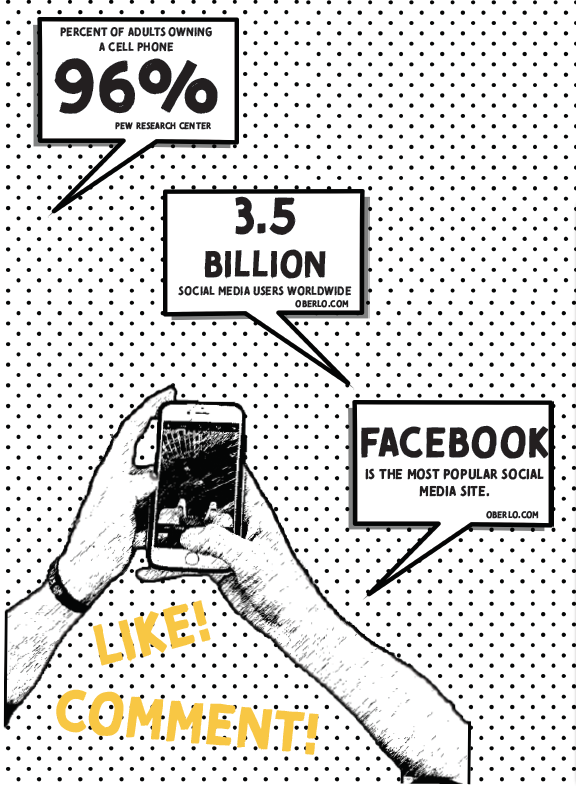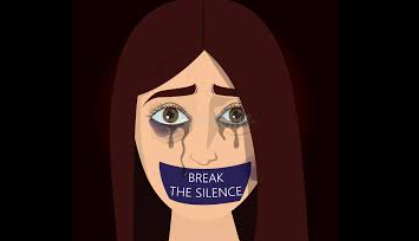The Dark Side of Social Media
Photo Credit: Bianca Fairchild
Cell phones have grown to be the biggest piece of technology in today’s society, with at least 96% of all American adults owning some sort of cell phone device. But even more so, teens are becoming more and more interconnected through smartphones, social media being the most prevalent platform. But as teens become more connected digitally, they disconnect from reality and the dark side of smartphones and social media emerges.
Social media’s facade of perfection
Social media is a huge part of the modern teenager’s life. It’s a tool to quickly share one’s life, experiences, relationships, and more to all their peers and beyond. Anyone can click on a profile to see the pictures, posts, and additional content the user has chosen to represent themself. For many, this is a huge cause of anxiety. The pressure to compete against peers to be just as “photogenic” or post good quality content on a regular basis creates a widespread feeling of insecurity across many users.
But much of what users see isn’t the truth. Media influencers, celebrities, and other role models have historically made young users jealous, under pressure to be as perfect as them. But the unrealistic picture of perfection has spread to teens’ common peers as well. Social media is good at setting up a facade of happiness and perfection. From the range of filters to look perfect, to the captions that describe the most exciting adventures . Users usually only post and share the highs, giving off the false perception that their life has no lows. The pressure, anxiety, and depression all add up on other users to be just as good, and have just as exciting lives as everyone else.
On top of that, some use dangerous shortcuts to get there. Eating disorders and mental health illnesses in teens may be partially caused by the pressure of social media. A study conducted by the University of Pittsburgh found that those who tend to spend more time on social media have an increased risk of reporting eating and body image concerns by between 220% to 260%. Another study conducted by the University of Pittsburgh School of Medicine found the more time spent on social media is proportional with sleeping problems and depression.
Heartbreaking headlines
The combination of cell phones, social media, and the internet all work together to bring a constant, instant access to a stream of news. The whole world can know of an event moments after it happens. But while this is a great way to be connected and informed, it leads to other consequences. Shootings, natural disasters, war, human right violations, terrorism, it seems there’s a new headline every day. The news consistently covers violence, destruction, and other negative news, and it leads to worse mental health effects. The media has also gained the stigma of focusing too much on negative news.
Human brains are built to deal with trauma. Our fight or flight instincts, seeking others for help, and more, it’s the whole reason we cry when we’re sad. But a constant stream of negative news can dampen these skills in the brain. Think about how the public reacted when Columbine was reported. Now compare that reaction to the 113 deaths and injuries from school shooting in 2018 alone, chances are most didn’t even know there were 113. As a nation, we’ve become so used to seeing negative headlines come in day in and day out, that it’s lead many to become numb, and unsurprised by news like this.
Yet while we may begin to feel numb, the news still takes it toll. On a biological level, each time we hear or see some form of negative news, stress hormones like cortisol and adrenaline are released. For some, this stress and anxiety is more powerful than others, but we’re all still affected. These levels of stress make it hard to return to a relaxed state of being, and because of the constant flow of negative news, that stress level
The shadow of irrelevance
On the contrary side of negative news, teens also like to focus on what’s not so important. Many teens love to follow big media influencers. As a result of that, they like to focus on news such as the lifestyle of influencers, the current fashion trends, or other arbitrary internet antics. This could even be a way to deal with all of the heartbreaking headlines we see every day. But while there’s truthfully nothing wrong with this kind of media attention, it creates another problem. When one becomes too immersed in this news, they can become blind to reality; and irrelevance out shadows important news.
Teens especially have this problem not only due to that, but also due to the fact that world news can be hard to understand many times. Because of these reasons many teenageres are very uninformed when it comes to the complex web of US, international, and other political news.
Being disconnected from the world leads to many worries. Many teens and young adults of today’s world still struggle to be involved and informed with both national and international news, and it leads to a lack of both local, and political participation. The US has one of the lowest rates of political participation compared to the other democratic nations of the world. While it’s due to many factors, a lack of education in politics is a large issue.
But teenagers aren’t the only ones to blame. The media does have a reputation in focusing on unimportant stories at times,
The impossible standard of communication
“I’ve been on delivered for 10 minutes but he was active on SnapMap 3 minutes ago?”
“She’s taking a while to respond, she must not be interested.”
“He didn’t like my photo, maybe he just hasn’t seen it. Or maybe he thinks it’s bad? Should I just delete it?”
If you’re a teenager, you’ve likely had a similar thought to these, or seen someone else go through it. Most social media platforms have some way to communicate or message other users, and platforms like Snapchat, have a main purpose to communicate. However nearly all these apps as well maybe provide the users with more info than most are comfortable with. Take Snapchat for example. Users can see exactly when their messages were delivered, opened, or even the exact moment they’re typing. On top of that, Snapchat rolled out a new feature called Snapmap, which provides users with the exact location of all their friends. Snapmap also shows when the user was last active on Snapchat. With all this combined, users can tell if someone saw their message but didn’t open it, if they did see it and didn’t reply, or if they simply haven’t even opened the app.
With all of these factors combined, it leads lots of people to conclusions about who they’re messaging. And it sets an impossible standard of communication. While it may be rude to ignore someone’s message, that’s not always what happens. The recipient may have gotten caught up in something else, had a bad connection, was thinking of a response but got distracted, or they may have simply just been too busy. There’s a plethora of reasons someone may not respond or open something instantly. But the problem is even the recipient knows they’re expected to respond as fast as possible. And they know they’re being held to that impossible standard, which creates high levels of anxiety and stress for them.
Health havoc
Cell phones have a large impact on both an individual’s mental and physical health. Beyond social media, phones have other mental effects. Addiction is a huge factor in many teenage lives. Teenagers grew up in the rise and revolution of smartphones, and many had their own by early teenage years. Many aspects of smartphones, such as social media, games, entertainment apps, and much more. All these different aspects promote dopamine to make users want to use them more and more, therefore causing addiction. Addiction leads to a plethora of symptoms when experiencing withdrawals, such as restlessness, panic, sweating and shaking. Addiction also makes other experiences hard to enjoy, appreciate, and handle when it comes to physical world interaction. Addiction also multiplies the effects of overexposure to social media.
Cell phones cause another health problem that isn’t necessarily due to the content of the phone itself, but rather the technology. Sleeping problems and disorders are a common physical and mental health condition caused by smartphones. Specifically, blue light is the culprit. Blue light is a color of the visible light spectrum visible to human eyes. Blue light is usually naturally only found in the sun and sky, where it serves to regulate the body’s circadian rhythm, or our body clock. But more recently, blue light is found in mostly any device with a screen. Overexposure to blue light causes numerous issues, such as eyestrain, fatigue, headaches, and sleeplessness. Numerous studies by Deloitte survey found that 50% of adults checked their phones within 15 minutes of going to bed, and 81% within an hour. 62% of adults also looked at their phones within 15 minutes of waking up, and 89% within an hour.

Born December 22, 2001
Snowboarder, pianist (kinda), aspiring mechanical engineer
Berserker Class

I would like to go into English Literature and Political Science and eventually become a professor. I am a three-year debate student who is way too busy....







